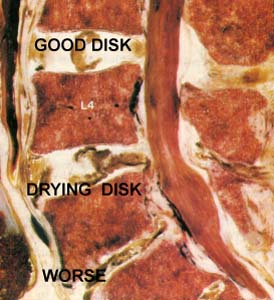
Young disks are high in water content and resilient with a rubbery consistency like the cartilage in chicken breast. With sufficient use the disks dry out, fissure, and shrink to a consistency more like worn out shoe leather which doesn’t absorb shocks as well. As a result: (1) the disks collapse and bring the vertebra closer together, (2) the spine’s exit holes for nerves become smaller, and (3) the undamped forces on the vertebra cause them to grow bony spurs along their edges and ligaments, further crowding the exiting nerves.
 |
 |
In the majority of cases these changes result in episodic back pain and stiffness but no nerve compression, nerve symptoms, or on-going nerve damage. Humans in this condition usually live with it and limit their activities as dictated by necessity. There are many therapies for this condition varying from the innocuous to the extreme. There are advocates and beneficiaries for each of these therapies but no scientific consensus to compel the pursuit of any of them. Optimists may exercise their freedom, nonetheless, and embark upon such therapies.

[page1 ]